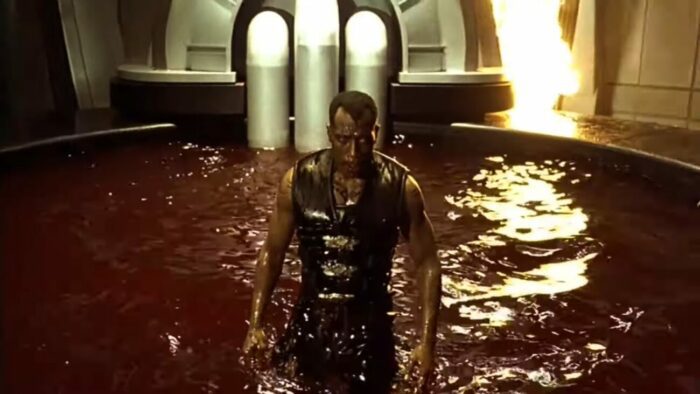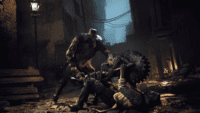When you think of Marvel, you probably don’t think of horror. Whether you like them or not, Marvel has cemented itself as a family-centric moneymaking corporate enterprise devoid of any true art or substance. But Marvel hasn’t always been the money-printing machine it is now, and in fact, it has horror to thank for its current relevancy. In 1986 the Marvel comic Howard the Duck was adapted into a film under the same name. It flopped, hard. A few years later New Line Cinema would acquire the rights to the character Blade, from the comic The Tomb of Dracula. Initially LL Cool J was in the running for the titular character, but would soon come down to Denzel Washington, Laurence Fishburne, and Wesley Snipes, even to New Line’s dismay as they wanted Blade to be white.
Created by Marv Wolfman and illustrated by Gene Colan, Blade was a side character in The Tomb of Dracula. Though the Blade most of us know is not the Blade from the comic. In The Tomb of Dracula Blade was just a man. He had no powers, he wasn’t a daywalker, but he was immune to being turned into a vampire. That is until a bite from Morbius turned him into the daywalking, vampire-slaying, stoically badass Blade we’d go on to dress up as for Halloween in 2008 (sorry I couldn’t find a picture of my costume). With David S. Goyer attached, New Line Cinema would make a film that would lead to the downfall of modern cinema and change the course of film history. Here’s why I think Blade II is better than Blade.

Blade would release to the world in 1998. With a budget of $45 million, Blade would make a whopping $131.2 million worldwide. As well as being an extreme financial success Blade was critically successful, and audiences ate it up. Because of Blade, comics could now be taken seriously by audiences who hadn’t really looked at them as legitimate forms of art. Blade could have gone a few ways, but rather than taking a campy and comic book format approach, like 03’s Hulk, Blade was a dark, broody, bloody, action-packed 2 hours. But here’s the question, is it really that good of a movie?
There’s no question that Blade is a solid action horror film, but that’s all it really is. Rather than the flawed character from the comics, we get a flat character and an even flatter story. Wesley Snipes absolutely nails the role, it’s just he doesn’t have much to play with. Blade barely speaks in the film, rather his performance is told through his lack of reaction and, as stated earlier, his stoicism. There’s nothing wrong with a character like that, but when you place that character in emotionally charged situations that are rife in comic book stories like this, you have to handle it properly or it doesn’t work.

Blade’s main emotional connection in the film is Whistler (Kris Kristofferson) and it’s clear Blade cares for humans but doesn’t excel at creating connections with specific humans. When he finally has a connection with hematologist Dr. Karen Jenson (N’Bushe Wright) we see somewhat of a caring side come out of him. Blade is imprisoned by his mother Vanessa (Sanaa Lathan), who he thought was dead this whole time, and he is drained of nearly all his blood. Karen saves him, but the only way he can defeat Frost (Stephen Dorff) and his mother is if he feeds on Karen. Keep in mind, he hasn’t fed on a human in a very long time. After feeding off of, and nearly draining, one of the only humans we’ve seen him become close with, he defeats his mother. These two pivotal moments fall completely flat. Goyer is an extremely competent writer and has written some absolutely incredible stories, he knew what he was doing when he wrote this scene. That doesn’t mean Blade needs to stop and cry and be all existential, but these two scenes need to be highlighted. THIS creates a flawed protagonist. Create the weight of the choices this character makes, rather than making them just participate in emotional activities without visualizing that in some way.
Both films have great cold opens, but how each film handles that energy couldn’t be more different. Blade starts with two partners who are going to a nightclub, only one of them doesn’t know the other is a vampire. Turns out they’re at Club Bloodbath. The sprinklers turn on covering the clubgoers with blood; that’s when Blade shows up and unemotionally slaughters them all. It’s action-packed, we get a ton of information on how Blade fights and how his handful of gadgets work. Blade II starts with meeting our villain Nomak (Luke Goss), as he enters a blood bank and brutally murders multiple workers. After that we get an alleyway fight scene with Blade and a handful of motorcyclists, it’s a fantastic wirework scene with excellent fight choreography.

Both films have an adrenaline-filled opening, setting a specific tone for what the film will be. That’s where Blade is outshined by Blade II. Blade isn’t that action-packed, it sets up false pretenses. There are about three main fight scenes in Blade with a couple of minor ones sprinkled throughout. On the other hand, Blade II sets up the villain and sets our expectations with the opening scene of action. Blade II focuses more time and energy on how the action scenes work within the story, which makes the overwhelming majority of it chock full of action. When we meet Nomak we are shown how strong he is, when we meet Frost in Blade he just looks like a brooding pretty boy. Now that is somewhat the point of Frost, he is underestimated by everyone in the vampire council, but they rightfully underestimated him…because he fails with his plan. Nomak is feared from the get-go, so whether or not he fails his mission there was no real question about his ability to do so. Frost is an awfully written one-note villain with no redeeming qualities. Nomak at least has a compelling backstory, terrifying strength, a wicked lip slit, and is just all around a better written antagonist.
A minor nitpick can be the use of practical vs digital effects. Setting aside this film was made in ’98 the digital effects in Blade do not hold up whatsoever. Blade II‘s digital effects do. The big thing is how Blade relied so heavily on digital effects, and set major plot points around certain effects, whereas Blade II nearly seamlessly mixes digital and practical effects to make a smoother looking film. There are deserved criticisms about some of the fight based digital effects used to enhance, and create, some of the fight scenes, and that’s fair. But how the digital effects are integrated into Blade II‘s fight scenes work, for me. Creating this almost rubbery, borderline cheesy, effect helps elevate this film into the idea that these vampires can move in ways no human ever could. It’s easier to be afraid of something that moves at superhuman speeds with movements we can’t do.

The overall story of Blade is better written than Blade II, but it’s less interesting. There’s little intrigue to the idea. Blade has a villain, Blade fights the villain, Blade wins. Blade II takes us down many roads, and turns into an ensemble piece. Both scripts were written by David S. Goyer, where the films really differ is within their respective director. Stephen Norrington was four years off of his cheesy sci-fi horror film Death Machine, and his direction of Blade feels almost exactly the same. Norrington brought the straight-to-DVD feeling to Blade that doesn’t vibe well with Goyer’s script. Blade II was directed by the one and only Guillermo del Toro two years before Hellboy. Guillermo del Toro understands this type of film and it really shows through the final product. Del Toro knows how to tell a story like this.
All of this isn’t to say Blade is a bad film, in fact, I have a deep nostalgic love for this franchise. Yes, even the atrocious Blade: Trinity. Blade is still an enjoyable film but I was shocked to see Blade has higher rated reviews than Blade II. Without Blade we would not have Blade II, it’s just that Blade II does what a sequel is supposed to do, and most fail at, by taking the ideas and concepts created by the first film and elevating them. With the film environment created by Marvel has created I don’t have high hopes for the upcoming Blade reboot, I’m definitely excited for it though. I hope they keep the dark and broody atmosphere the first two films have, while still keeping the character of Blade as a stoic, vamp slaying, daywalking badass.




